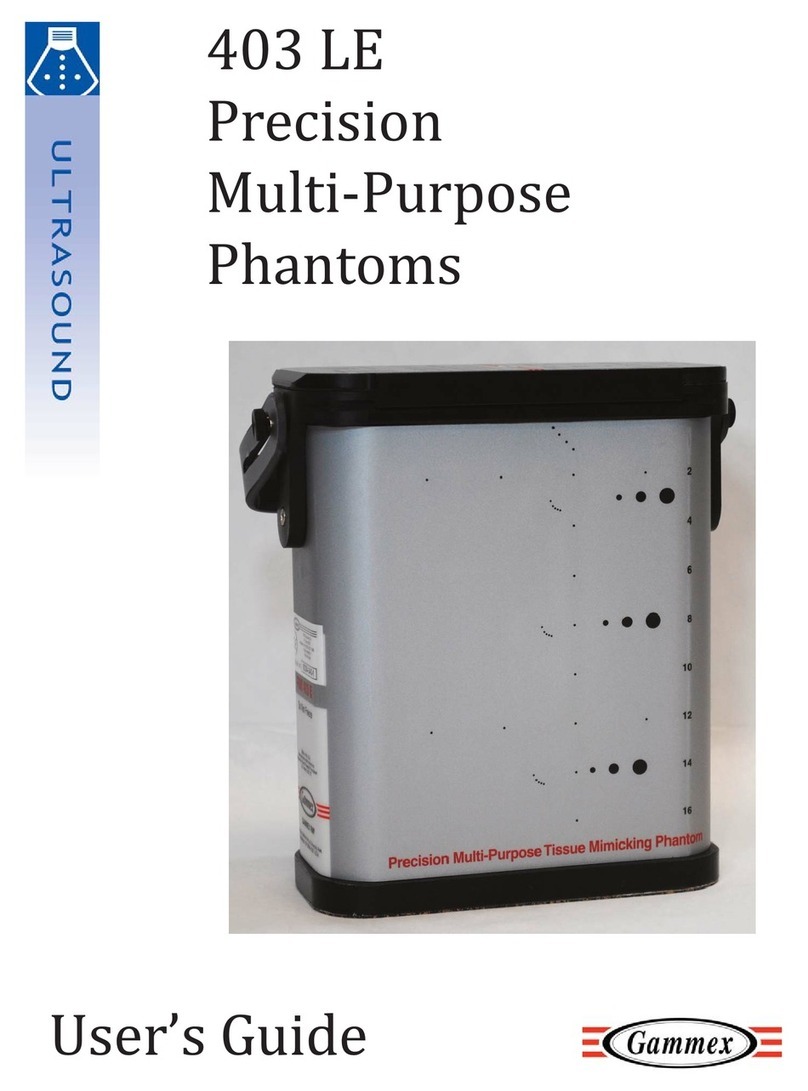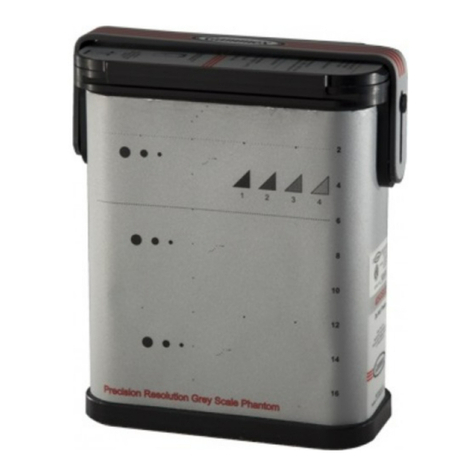
Contents v
Preface . . . . . . . . . . . . . . . . . . . . . . . . . . . . . . . iii
Intended Use. . . . . . . . . . . . . . . . . . . . . . . . . . . . . . iii
Quality and Regulatory Systems. . . . . . . . . . . . . . . iii
Health and Safety Instructions . . . . . . . . . . . . . . . . iii
Regulatory Information . . . . . . . . . . . . . . . . . . . . . . iv
Finding Additional Information . . . . . . . . . . . . . . . . iv
Document Conventions. . . . . . . . . . . . . . . . . . . . . . iv
Introduction . . . . . . . . . . . . . . . . . . . . . . . . . . . . 1
Description . . . . . . . . . . . . . . . . . . . . . . . . . . . . . . . 1
Parts . . . . . . . . . . . . . . . . . . . . . . . . . . . . . . . . . . . . 1
Accessories. . . . . . . . . . . . . . . . . . . . . . . . . . . . . 2
Phantom Assembly. . . . . . . . . . . . . . . . . . . . . . . . . 2
HE Gel . . . . . . . . . . . . . . . . . . . . . . . . . . . . . . . . 2
Targets . . . . . . . . . . . . . . . . . . . . . . . . . . . . . . . . 2
Flow System . . . . . . . . . . . . . . . . . . . . . . . . . . . . 3
Phantom Top Panel . . . . . . . . . . . . . . . . . . . . . . . . 3
Scanning Surface . . . . . . . . . . . . . . . . . . . . . . . . 3
Water Dam . . . . . . . . . . . . . . . . . . . . . . . . . . . . . 3
Sono Transducer Holder. . . . . . . . . . . . . . . . . . . 4
Control Panel . . . . . . . . . . . . . . . . . . . . . . . . . . . 4
Mode Controls. . . . . . . . . . . . . . . . . . . . . . . . . . . 4
Power Supply . . . . . . . . . . . . . . . . . . . . . . . . . . . 4
Operation . . . . . . . . . . . . . . . . . . . . . . . . . . . . . . 5
Setting Up . . . . . . . . . . . . . . . . . . . . . . . . . . . . . . . . 5
Scanning Using an Abdominal Transducer. . . . . . . 5
Scanning for Color Flow Imaging . . . . . . . . . . . . . . 6
Scanning with Doppler Signals . . . . . . . . . . . . . . . . 8
Doppler QA. . . . . . . . . . . . . . . . . . . . . . . . . . . . . 9
Doppler Signal Sensitivity and Penetration
Depth . . . . . . . . . . . . . . . . . . . . . . . . . . . . . . . . . . 9
Color Flow Sensitivity and Penetration Depth. . . . 10
Low Flow Sensitivity at Depth. . . . . . . . . . . . . . . . 10
Color Flow B-Mode Image Congruency . . . . . . . . 10
Directional Discrimination . . . . . . . . . . . . . . . . . . . 11
Flow Velocity Profiles . . . . . . . . . . . . . . . . . . . . . . 12
Flow Velocity Accuracy . . . . . . . . . . . . . . . . . . . 13
Sample Gate Positioning Accuracy. . . . . . . . . . 14
2D B-Mode QA . . . . . . . . . . . . . . . . . . . . . . . . . 15
B-Mode Sensitivity and Penetration Depth . . . . . . 15
Image Uniformity and Transducer Integrity. . . . . . 16
Distance Measurement Accuracy . . . . . . . . . . . . . 17
Lateral and Axial Resolution and Image
Geometry . . . . . . . . . . . . . . . . . . . . . . . . . . . . . . 18
Gray Scale Display. . . . . . . . . . . . . . . . . . . . . . 20
Qualitative . . . . . . . . . . . . . . . . . . . . . . . . . . . . . . . 20
Quantitative . . . . . . . . . . . . . . . . . . . . . . . . . . . . . . 21
Baseline Test . . . . . . . . . . . . . . . . . . . . . . . . . . . 21
Subsequent Tests . . . . . . . . . . . . . . . . . . . . . . . 21
Dual Display Analysis . . . . . . . . . . . . . . . . . . . . . . 22
Support and Maintenance . . . . . . . . . . . . . . . . 23
Caring for the Doppler 403 Flow Phantom . . . . . . 23
Cleaning. . . . . . . . . . . . . . . . . . . . . . . . . . . . . . . 23
Storage . . . . . . . . . . . . . . . . . . . . . . . . . . . . . . . 23
Weighing . . . . . . . . . . . . . . . . . . . . . . . . . . . . . . 23
Rejuvenation and Recertification . . . . . . . . . . . . 23
Charging the Battery . . . . . . . . . . . . . . . . . . . . . 24
Maintenance . . . . . . . . . . . . . . . . . . . . . . . . . . . . . 24
Repairs . . . . . . . . . . . . . . . . . . . . . . . . . . . . . . . 24
Parts . . . . . . . . . . . . . . . . . . . . . . . . . . . . . . . . . 24
Disposal and Recycling . . . . . . . . . . . . . . . . . . . 24
Contacting Gammex Technical Support . . . . . . . . 24
Specifications. . . . . . . . . . . . . . . . . . . . . . . . . . 25
Specifications . . . . . . . . . . . . . . . . . . . . . . . . . . . . 25
Appendix A: Flow Velocity Accuracy. . . . . . . 27
Flow Profiles in the Doppler 403 Flow
Phantom . . . . . . . . . . . . . . . . . . . . . . . . . . . . . . . 27
Mean and Maximum Velocity Calculations . . . . 28
Beam Width Effects . . . . . . . . . . . . . . . . . . . . . . . . 30
Beam Width Effects: Spectral Broadening . . . . . . 31
Appendix B: Harmonic Imaging . . . . . . . . . . . 33
Harmonic Imaging in Medical Ultrasound . . . . . . . 33
Phantom Use in Harmonic Imaging. . . . . . . . . . . . 33
Gray Scale Applications . . . . . . . . . . . . . . . . . . . . 35
Appendix C: Additional Reading . . . . . . . . . . 37
Appendix D: Regulatory Supplement. . . . . . . 39
Symbols. . . . . . . . . . . . . . . . . . . . . . . . . . . . . . . . . 39
Operator Responsibility . . . . . . . . . . . . . . . . . . . . . 39
Reporting Health or Safety Related Issues or
Concerns . . . . . . . . . . . . . . . . . . . . . . . . . . . . . . 40
Modifications to Equipment . . . . . . . . . . . . . . . . . . 40
Interaction with Other Electrical Equipment. . . . . . 40
EMC Precautions. . . . . . . . . . . . . . . . . . . . . . . . 40
Warranty . . . . . . . . . . . . . . . . . . . . . . . . . . . . . . 41
Contents






























